Two tutorials in a row? What on earth is happening??
Thanks to a reader email, I’ve been looking at matte top coats and DIY-ing them recently. Before we get to the DIY part, here’s how matte top coats work – it’s pretty simple!
Much like linear vs scattered holo finishes, it’s all about how smooth the surface is – in a glossy finish, the particles are uniformly spread on the surface in an even layer, and so the reflection is continuous. In a matte finish, if you zoom in to a microscopic level, the surface is rough and therefore the light bounces everywhere and you don’t get a smooth reflection – the light is diffused and scattered, which gives a dull finish.
The ingredient in commercial matte top coats that makes the surface rough is silica gel – the same as the stuff in those little water-absorbing dessicant packets, but ground up very very finely. (For those of you who like exact sizes, it’s finer than lab-grade 40-63 μm silica gel, which gave a bumpy, gritty finish when I mixed it with clear polish.) But silica gel isn’t that easy to get a hold of, and at a size that small, if you don’t have the proper equipment, it’s pretty horrible for your health (and if you get your hands on the wrong stuff, it can kill you in a painful way).
DIY Matte Top Coat
I’ve seen plenty of recipes floating around that give the two ingredients for an easy DIY matte top coat: cornflour (corn starch) and top coat. But I haven’t seen any with exact measurements, so I set about experimenting with quantities. I tried three different ratios of cornflour and top coat:
1/8 tsp cornflour in 1 mL Seche Vite
1/6 tsp cornflour in 1 mL Seche Vite
1/4 tsp cornflour in 1 mL Seche Vite
I firstly transferred 1 mL of Seche Vite to an empty bottle and added two bearing balls for mixing. I measured the cornflour using a 1/8 teaspoon kitchen scoop, and made a little funnel out of sticky tape and paper to assist in pouring (cornflour is pretty messy, and unlike glitter, doesn’t look so pretty on the carpet or your clothes). When I mixed the cornflour with the top coat, the result was a discouragingly opaque white gloop:
But when I swatched it, it ended up looking pretty impressive! I compared my cornflour frankens to the two commercial matte top coats I own, Rimmel Matte Pro and OPI Matte top coat. The base colour is OPI Incognito in Sausalito, from the San Francisco collection.
1/8 tsp cornflour in 1 mL Seche Vite is clearly the winner here – the finish is more satiny than the two commercial matte coats, but it’s definitely well away from glossy. Adding more cornflour just seemed to overload the top coat with solid clumps of cornflour particles, which made it crack or end up with white specks. 1/8 tsp per mL is as much cornflour as you can cram in there.
I think this might be more like the “wax” finish from Cult Nails than a true matte, but it’s possible that a different brand of corn flour, or even using other finely powdered starches (rice flour, or wheat starch) could give a different result.
If you’re playing at home, keep in mind that different brands of cornflour will be different (as well as different brands of top coat, and different lengths of time they’ve been open), so I suggest that you take 1/8 tsp per mL as a starting point and adjust accordingly. If you can’t get the cornflour to mix well just by shaking, stand the bottle upside down overnight and it should be much better in the morning.
(If you’re mathematically challenged, to work out how much cornflour you need, divide the number of mL of top coat you’re using by 8 to get the right amount of cornflour, in teaspoons.)
And if you have leftover cornflour, you can make fun slime!
Edit: Just realised there’s an apt GIF for this post! That’s cornflour, I swear!
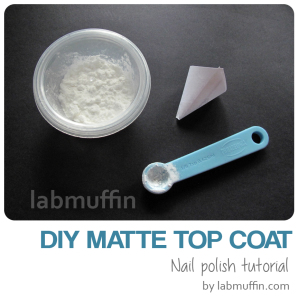

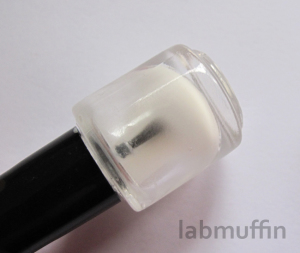
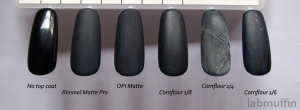


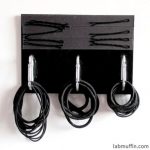
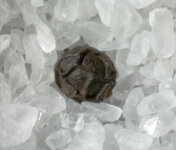

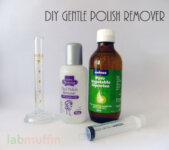
As always – another great post! I might try this if I never get around to buying my own bottle of top coat.
Thanks! It’s one of the easiest DIYs ever!
Stop it, stop being so amazingly smart! You’re dazzling me with your brilliance and my mind can’t take it anymore!
Awww thanks! My degrees ended up being good for something practical after all 🙂
I have a crappy BYS Matte Top Coat that does NOT work.. do you think I could add some cornflour to it? I might have to give it a go… nothing to lose 🙂 thanks for the tut!
You could give it a go, but add only a little at a time – you’ll probably need a lot less than 1/8 tsp per mL!
If you have even more leftover cornflour, you should try this https://www.youtube.com/watch?v=ClqRFpQuaZ8 (not creepy, just a wonderful QI video about cornflour!)
Yes! I love his description of the writhing cornflour!
Potato or arrowroot starch also tends to be fairly finely milled and might work, although I haven’t tested (lacking patience, etc). Rice powder tends to be quite gritty unless it’s practically micronised, I’ve found.
Thanks for the info! If I manage to gather enough starches I might do a comparison later, but I haven’t really looked into whether commercial corn flour is similar across all brands or if there’s a lot of variation, so it’s possible that there’s a corn flour out there that’s super matte already…
Wow, how clever! I’m not a fan of matte finishes, so I just grabbed the cheap Hardy Candy brand matte top coat for the rare instances that I may want it for nail art. I like knowing that you’ve found the recipe for a good waxy finish, though! Definitely cheaper than most mattifying tc’s…
Also, just as an out-of-curiosity note: When you tried to make this the first time with silica that was not fine enough, and it turned gritty instead, could that be used for layering under a creme finish polish to make the color appear textured? Once again I’m only into the textured finishes for nail art, but obviously that is a “big thing” right now, and I’ve seen a few people trying to franken them or achieve the look by layering.
Brilliant work as always. I do so love your sciencey (the technical term, I’m sure) write-ups. Makes me feel all educated about the stuff I enjoy so much! =)
It wasn’t quite gritty enough to be liquid sand – it was a horrible sort of in-the-middle gritty! I’ve seen people use gritty glitters under other shades as liquid sands, as well as people who’ve used actual sand (the stuff people use for decorative layered sand in jars) – I think those would work better than the useless stuff I made, unfortunately.
As you’ve probably gathered, I abhor technical terms and just ram neologisms (heh.. ram and jism) anywhere they’ll fit 😛 Sciencey is definitely a word within the Lab Muffin vernacular!
I love how informative your posts are! 🙂 Nice study! Hehehe, I will be sure to play around with cornstarch sometime! 😀 Thank you!
Looking forward to seeing your results 🙂 I have a feeling that different corn starches will give different levels of matte, but I’m prepared to be wrong!
Any thoughts on the amount of silica gel for those of us that are fortunate enough to work in a lab?
No idea, but I found that the 40-60 μm silica gel I used really didn’t want to stay suspended (although I didn’t try playing around with suspension base). Finer gel might overcome the density problem, but I didn’t have any handy. Celite could possibly work too, although that tends to be off-white. I also thought about using some C8 reverse phase stuff that I’d recovered from some old columns no one wanted anymore, that was too fine to use for flash chromatography, but never got around to it – that could be a cheap source for smaller sized silica gel.
This is awesome! 😀 Now I just wish when I wore matte top coats it didn’t chip as quickly. . .is this the same for you?
Matte doesn’t chip faster on me, although I do use super-chippy SV as my normal top coat, so make of that what you will 🙂
i love this post!
Glad to hear it! 🙂
I have a silica finishing powder (the Australis one, but I think that Make Up Forever have one too) – would this work do you think? It is extremely fine.
It’s worth a try! 🙂
Amazing DIY! The Krueger gif made me lol, love Archer!
Thanks! Archer is hilarious 🙂
Thank you for such informative details. I have only just come across your web sit. You re one special and talented lady
I am a Cosmetic Chemist:
The actual Good cosmetic practice is using Silica microsphere. Depending on the level.used you can achieve matte to crackle. So example 11ml polish 1 to 3 mini scoops will achieve matte
Crackle
Egg 65 percent by weight polish base
25 percent by weight isopropyl alcohol
5 percent by weight silica
2 percent by weight pigment
Matte
95 percent by weight base
2 to 4 percent silica
1 percent pigment
Enjoy
hi! as an aside: tapioca starch is said to be “clear”..i’m not entirely sure i get this, but its from multiple mineral makeup making (mmm..) sources; maybe its just true for face or base powder, but possibly in this application, it might prove to be useful; like in the example you showed where the 1/4tsp nail appeared chalky, maybe the tapioca starch would just look more dull? i haven’t tried it myself, so i can’t say..
but, b/c of the aforementioned mmu-making hobby, i also have some shimmery serecite mica that i might try for a topcoat, using your successful ratio as my starting point-that could add some nice depth to my plain clear nubbins..
thanks for an inspirational post & an altogether awesome blog!
muchlove, suki
Thank you so much! Good luck 🙂